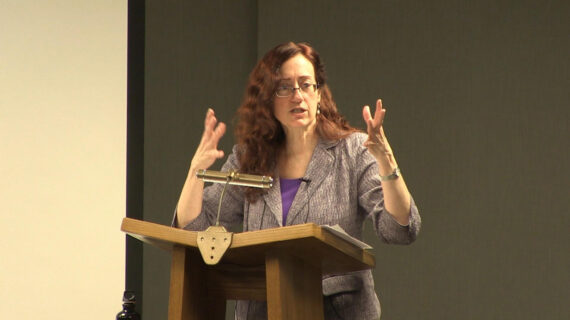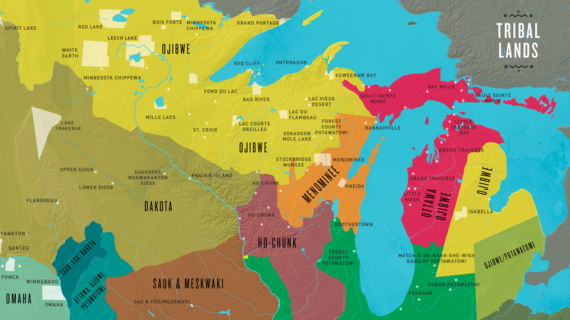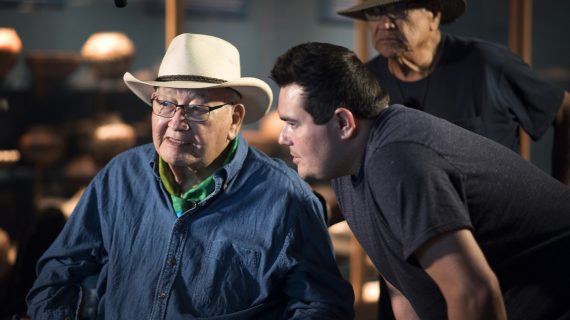– I’d like to introduce our guest speaker for tonight here at Space Place. Tonight I’m very pleased to introduce an astronomer from the UW Astronomy Department, but also a friend of mine, Eric Hooper. Eric came to us, he got his PhD at the University of Arizona in astronomy, and then came here after working at UT Austin, came here to Madison where he’s been here for a few years now doing a lot of different things, but including a two-year stint as director of the WIYN Observatories. You might remember the W in WIYN is for Wisconsin. It’s a set of telescopes that we manage from here, and Eric was the director of those for a term there. But tonight, he’s gonna tell us about some of his research with the intriguing phrase cosmic archeology, but I’m gonna turn it over to him right now. So please welcome Eric Hooper. [clapping]
– Thank you, Jim. And thank you everybody for coming out this evening. I really appreciate it. We have a big crowd here. I’m gonna start out by just giving a shout out to the organization that’s funding this work, and that’s the National Science Foundation. They provide funding across the country for a lot of different interesting science, not just in astronomy, but across the whole spectrum of science, technology, engineering, and mathematics. And I’m not the only one on this project. So let me introduce some of the other cosmic archeologists. I’ve included the pictures of our local team here. These are all University of Wisconsin Madison astronomers. The two on the left and right are graduate students who, of course, do most of the work. The person in the middle is the PI or the principal investigator. She’s the leader of the grant. The other two are faculty collaborators of ours. But we’re not just a UW of Madison team. There are other people I’ve showcased down here at the bottom. These are collaborators from across the country, and as you also see, from other parts of the world. These are part a large international team called the Sloan Digital Sky Survey. We’ll talk more about that later in the talk, so I’m just giving you a little foreshadowing of that here. And one of the themes about this that you’re gonna see throughout this talk is that a lot of modern scientific research, including in astronomy, is done by teams of people, this is actually a relatively small team, and also utilizing a wide variety of different technologies and techniques. That’s gonna be part of the story of this evening, is what those techniques and technologies we’re using to address the project I’m gonna tell you about. Well first, we have to deal with that title, that weird title that Jim alluded to. He’s really hoping I’m gonna explain what it is.
I know that some of you may be thinking, “Oh, that guy, this is a marketing ploy. He just made up the weirdest title he could think of to get a crowd out tonight.” Well, maybe a little bit. But the fun part of tonight’s talk is that it is not completely crazy. There’s actually a grain of truth in everything in that title, and I’m gonna explain a little bit of that here. And the entire talk is encapsulated, really, in the title. So it’s more than just crazy marketing. There really is meaning to everything that’s in that title, and I just wanna unpack that a little bit here. But first, a quick story, little anecdote, how I actually came up with this. It wasn’t for this talk, although the details of it for this talk, but it occurred to me while I was traveling sometime. I was flying and I was on an airplane. And, as often happens, you sit next to somebody and they ask, “Well, where’re you going after Chicago?” And after you say, “Well, I’m going to Kalamazoo and they’re going to Walla Walla,” then the conversation goes to, “Oh, well, what do you do for a career?” And we sometimes get some interesting responses when we say we’re astronomers, because there’s just not that many of us in the world.
And some people find that really intriguing. Some people find that really strange and they don’t know what to do. and I’ve often thought, “What could I say that would have a grain of truth to it that would really make people think it’s kinda weird?” So I’ve thought, I guess I could say, given the project I’m working on now, I could turn to them. I could say, “Yeah, so, I’m a time-traveling cosmic archeologist. And by the way, let’s talk about this on the 15-hour flight to Shanghai.” [laughing] All right. So let’s unpack what I actually mean here. Clearly the most ridiculous sounding part of that whole title is the archeology. I mean, what does astronomy have to do with archeology, other than they both start with A? I have heard, oftentimes, that astronomers, and maybe others, use archeology as sort of a metaphor for astronomy. Here’s why. Because there is an element of looking into the past that’s inherent in astronomy. The reason for that is that light, and any information that comes with it, has a finite travel time. Now, that may not be readily apparent to us in this room because the speed of light is so rapid, but when you’re talking about the vast distances that we are often dealing with in astronomy, then it starts becoming relevant. For example, the Sun’s light that we see, is already a few minutes old. That’s not that far in the past. Center of the galaxy, when we look at it, is over 20,000 years old. The nearest large galaxy, now we’re going over a million years old. So by having things very far away when we look at them, we are inherently looking into the past.
Maybe a more down-to-earth analogy. I don’t know if maybe today in middle school and in elementary school they don’t do this, but in my time kids would pass notes to each other. So here’s the analogy. Somebody starts passing around the note around school that so-and-so likes whosie-what-sit. And by the time that note makes it all the way around school, so-and-so and whosie-what-sit have already broken up. So by the time you get that, if you’re at the end of the chain, you have just discovered information, it’s real information, but it is lagging in time. It’s out of date. And that is unavoidable in astronomy. And so that’s why people often will say, “Astronomy’s a little bit like archeology in that sense.” But not really. There is a difference. And in astronomy, when you’re looking back in time at something that is old because it’s far away, it’s not that we are digging up pieces of the past and looking at them as they are now. It’s as though we are actually able to look at what really happened. Take Pompeii, for example, on that fateful day when Vesuvius blew up. It would be as though rather than going to Pompeii now and unearthing artifacts from that time, we were able to look from a distance and watch the life of the city in the morning, watch the residents go about their day on that final day. Now, it would not be a very clear view because it would be a long ways away. We would not have really good images or pictures of it, but that’s what we would be doing. We’d actually see it going through and happening as it occurred. So in that sense, it’s not like archeology. That’s the time travel bit in my title.
But wait, there is also an element of archeology, in that what we are trying to do, and I’m going to describe to you, is look back in time at distant objects and look for artifacts. So we are doing both. It is time traveling and it is archeology. We’re trying to understand what has been happening with galaxies and the black holes they contain, at times previous to when we see them. Why? We’ll talk about that. So, we’re gonna talk about a fair number of things this evening. Big ones are black holes and galaxies. That’s what this whole project is about. By the way, this project, this time traveling archeology, this is a field report. We’re not completely done yet. We’re in the middle of it. We’ve got a lot of work done. This is an update. This is like when you’re watching a show about archeology on TV and they are just starting the dig and they’re out in the jungle and they’re getting hot and sweaty and they’re getting bitten by scorpions, that’s where we are, we’re at the scorpion-biting phase of this. So we’re gonna talk about black holes, supermassive or monstrous black holes, and galaxies. The black holes living inside at the centers of the galaxies, how are they connected? That’s the fundamental question that we’re after. And what have these been doing in the past, specifically the stars that are in the galaxies? Galaxies are made up of a bunch of different things that we’ll talk about here in a minute, but the stars, what have they been doing? And what have the black holes been up to in the past? We’re gonna talk about some new observations with a big radio telescope. You may be thinking of the one in New Mexico. Some people may be aware of that. A little farther away, a little bit bigger.
As I mentioned, a lot of modern science needs multiple different approaches all integrated together. One of the things we’re doing are massive simulations, theoretical work using computers to try to understand better what we’re actually seeing with some of these telescopes. And also, we’re utilizing visible light surveys of the sky as well. So that’s where we’re going this evening. Black holes and galaxies. I talked about that this was gonna be a connection between them, a story of the connection between them. Time traveling in the sense of looking backward or into the past and see how they actually were at time. Archeology in the sense that we are going to be looking at relics in the past of yet even in earlier history of both the galaxies and the black holes. But before we dig into these connections, let’s actually talk about, remind ourselves what are the black holes and what are galaxies? On the left here, is a series of depictions of a black hole. Little bit hard to get a real picture.
This is more than an artist’s conception. This is actually a computer simulation of a disk of material around a black hole. Anybody recognize it? It may look vaguely familiar. It’s a simulation that went into the Hollywood movie Interstellar. So that the filmmakers there wanted to have as much scientific accuracy as they could within the constraints of the production. So one of their major scientific advisor, who I understand worked very closely with them, is a fellow named Kip Thorne. Kip Thorne recently won the Nobel Prize in physics for working on gravity-related things. So he knows a thing or two about black holes and gravity. He has literally written some of the books on them. He worked with their special effects team to make as realistic as possible simulations. So going down from the top here, if anybody saw the movie, this is closest to what was actually depicted in the movie. The black hole is here in the middle. More specifically, that’s its event horizon. And this material around it is called the accretion disk. It’s material flowing into the black hole. This was depicted in the movie, but more realistic are these down here, these two. These are progressively more realistic. What they put in the movie did not have an effect known as Doppler shifting, which changes colors depending on whether the material’s moving towards you or away from you. And there is also an effect of relativity that makes things moving very fast towards you appear brighter, over here, and things that are moving quickly away from you appear dimmer. So this is how, right here, a bit closer to how the black hole would be more realistically in appearance, but that was thought to be a little bit, potentially too confusing to the audience.
I was reading about this, interestingly enough, in a scientific paper, in a journal called, Classical and Quantum Gravity, Kip Thorne and the special effects people wrote a paper, more than one, I think, about doing movie special effects in Classical and Quantum Gravity. It’s actually a really fun paper. And down here, finally. . . This is an attempt to explain why it looks so weird. Anybody, when they saw the movie, wondered why is there material, if you’ve heard of an accretion disk, why is it above and below as well as from side to side? It’s an effect of gravity called gravitational lensing. This up here is a colored disk. It’s a color swatch that changes color radiating outward and is the same all the way around. If you take this and put it in front of the black hole, because of the warping of space time by gravity, this is what you see.
So this is really just a nice, uniform color swatch, but see how it gets distorted around there? Gravitational effects through the warping of space time. Anyway, that’s my little introduction into black holes. By the way, I, and it turns out, other astronomers, had assumed that when we saw the movie that this is what’s called a stellar mass black hole, something that has relatively, as you will see, low mass, though it’s not low by our standards, a few times the mass of our Sun. And it’s the product of a large massive star dying leads to a black hole like that. We all assumed that’s what this is. Well, in reading about it, Kip Thorne actually modeled this as what’s called a supermassive black hole. The black hole that was in the simulations is 100,000,000 times the mass of our Sun. And I was delighted to see that, because what I am talking about here are supermassive black holes, black holes with masses of millions and even billions of times the mass of the Sun. So this is actually a very relevant depiction of this. So that’s a bit about black holes, supermassive ones. They live in here, in the middle of the galaxy. We live in a galaxy. If you go outside, maybe later at night if it’s clear, get out where some lights are, away from some of the lights, you can see it’s the Milky Way, that’s our galaxy. This is not a picture of the Milky Way. Some people may recognize this as a picture of the Sombrero Galaxy taken with the Hubble Space Telescope. It’s meant there as kind of a generic but very pretty depiction of the galaxy, you see some of the parts of it. You see the fuzz there, the lighted fuzz, those are stars. This is an enormous number of stars whose light’s all blended together. The dark plane is a disk of gas. We have a plane in our Milky Way.
Our Milky Way doesn’t look like this quite. It is a different type of galaxy, but it does have that disk in it, does have that dust in it. And then right at the center of almost every galaxy we know about, there is one of these monsters. There is one of these supermassive black holes. So we live in a galaxy. There’s a supermassive black hole living in the galaxy, almost every one. What does that mean about us? I can tell you. There’s somebody in here tonight, sitting right now, and there is a supermassive black hole behind you and underneath your chair. One of you, one of us. Anybody getting nervous? [laughing] You don’t have to worry. That one person is me. The supermassive black hole in our galaxy is roughly there. It’s in that direction, still below the horizon. It’s not that long ago. It’s okay. I don’t have to worry about it. It’s a long ways away. It takes 25,000 years for anything to happen to get to us. And black holes don’t have some mysterious sucking power. They’re not gonna suck an entire galaxy in, and things have to get relatively close to them.
So we’re gonna be okay with that. But if you do get material close to them, and that material falls into this accretion disk, hapless stars, unfortunate planets that may be around them, gas, dust, whatever happens to get in there, loses an enormous amount of energy. It’s falling energy. It’s just like if something fell down, it breaks. Imagine something falling with so much more energy than we can conceive of on Earth, and it releases some of that before it falls into the black hole, that can power a rather remarkable thing. It’s called an active galactic nucleus. It’s the visible manifestation, and when I say visible I don’t just mean visible light, I mean all different kinds of electromagnetic radiation as we’ll talk about, it’s the manifestation of one of these supermassive black holes consuming material and then jetting out some of that material and a lot of light. And those jets come out at very close to the speed of light and they can be huge. So getting over to the panel on the right. Now we’re putting the two of them together.
This is an image of a cluster of galaxies. Each little fuzz ball in there is its own galaxy. It’s like the Milky Way in which we live. Some are bigger, some are smaller. Those red plumes, that’s a false color. They’re not actually red. They’re representing radio jets and lobes. A lot of times the largest physical manifestations of these active galactic nuclei, these supermassive black holes gobbling up material, sending up these enormous jets at close to the speed of light are in the radio. I mentioned the radio telescope earlier, so that’s where we’re going with this. And you can see how much bigger sometimes these are. They can be much larger than the galaxy. They can be a substantial fraction of the size of a cluster of galaxies, like is in this case. So now, what might be the connection? That’s where our story’s leading. It’s the connection between black holes and galaxies. Again, it’s a time travel story because we’re looking at things that are distant, and hence back in time. It’s an archeological story because we’re looking at relics back in time to try to understand what has happened earlier and earlier in time. And what we’re trying to understand is how the black holes and the stars in the galaxies might be connected with each other. This is why we’re thinking about this, because there is growing evidence that there is a very fundamental connection. The work on the left is not ours. It’s a published paper.
The citation right there. But it’s showing a cluster of galaxies. Again, the light fuzz balls are individual galaxies. The blue is an X-ray image. We don’t see X-rays, but we have to represent it somehow, so it’s a false color image. The X-rays are blue. Again, the radio’s in red. You see those large radio plumes. If you look closely, the radio plumes appear to be in areas where there’s not many X-rays. The X-rays are tracing the hot gas around these galaxies around this cluster. The radio plumes driven by this AGN or active galactic nucleus have driven out this material. There’s a term called feedback. This is something that people have been getting more and more interested in, not only because of observational evidence like this, but theoretical evidence. Folks who have been getting better and better at modeling how galaxies form, they basically create an entire universe inside a computer. They create gas, primordial gas, add dark matter, this mysterious stuff. We really don’t know what it is. And watch what happens. And gravity will cause the gas and dark matter to collapse, which will form galaxies, stars, et cetera. They’ve gotten better and better and better at this across my career. It’s actually been remarkable at how much progress they’ve made.
But there was a problem. Stars formed too quickly, more than people see. Too many stars faster than we actually see in real galaxies. What to do about this? There had to be some way of suppressing that star formation, some kind of feedback mechanism that as gas flowed into the galaxies would then puff it back up again. Two main candidates for that, the stars themselves. Some stars explode, huge explosion, super nova, they blow the gas back out or heat it. The other one’s these, the active nucleus. The material flows in, it can light up the black hole, turn on the active galactic nucleus, puff out the material, shut itself off, and maybe shut off the star formation in the galaxy. This is where we’re going. It’s that connection. People have been working on this to try to understand this better and better. It’s probably a fundamental link between the supermassive black holes at the center of galaxies and the stars in the galaxies around them. The specific question we’re trying to address is time scale. Is there any connection with when a supermassive black hole became active, like is shown here, and any star formation events, the history of the formation of stars in the galaxy. Is there any connection between. This would indicate there would be. The theoretical work indicate there would be. But what’s the timing? Does the AGN turn the active galactic nucleus on first, same time, afterwards? How are they relative to each other? Is there always a connection, or is there really no connection in timing? Is it maybe just a little bit that happens below what we can detect? So these are the type of questions that we’re trying to answer. So if we’re trying to see a connection in time between what the black hole is doing and what the stars in the galaxy are doing, we can’t just look at a galaxy and a black hole at the same time. Well, you can.
People have done that. That’s done a lot. But you’re limited. You’re looking at a snap shot in time, one time. Remember, you’re looking at Pompeii that morning. You’re not seeing what had happened 500 years earlier in Pompeii. For that, you need to go back to that morning in the early 80’s and go dig up something. That’s the time traveling archeology, and that’s what we’re trying to do here, is go dig up things and see if we can make a connection in that time scale. And the plot on the left here is just a schematic. The thing in the middle that looks like a sun is actually meant to represent an active galactic nucleus. That’s a supermassive black hole. Over here, on the right part of that, is the outflow. And it may even trigger star formation. So the idea, the main idea people are thinking about now is that these active galactic nuclei may shut off star formation, but they may also trigger it. That’s an idea that’s been around a long time. I remember hearing about that in graduate school. So there may be a lot going on here. And this is the question I was addressing just here. What is the time scale here? So to do this, we need a couple things. This is the archeology again.
We need to be able to trace a black hole’s activity history. What has it been up to in the past? Was it active in the past, or was it just sitting there? Remember, it’s only active if you have material flowing into it. That accretion disk, if it runs out of material, it just sits there. Also, we need to be able to trace the galaxy’s star formation history. What were the stars doing? Do we see a connection? Was there an episode of activity in the black hole in the past that then shut off the star formation, that then triggered the star formation? Did the star formation happen first and then trigger the black hole or shut it off? How do these things connect with each other? That’s what we’re trying to get at here. And we can do that with a black hole, at least, the active galactic nucleus, we can do that if we look at them with radio light. Remember, I said those huge plumes were radio emission, particularly at low frequency. And we need to be able to trace the galaxy’s star formation history, and we can do that with visible light observations. That’s the story of this evening, the rest of the evening here. So getting to how we figure out what the stars have been up to, this is a very brief rundown of a rather complicated topic.
But the principles are okay. Over here on the left is something called a Hertzsprung-Russell diagram or a color magnitude diagram. We don’t need to worry about the terminology too much. It’s a plot. This is color. They’ve nicely color-coded it. This end is red. That end is blue. So it’s color, blue to red, and up here is brightness. This is fainter, that’s brighter, and these represent stars. This is the culmination of decades of work, particularly in the first half of the 20th century, to understand, to not only measure these things but understand how this changes with time. And what happens is that when a bunch of new stars are first born, they lie all along here. This is called the main sequence. And the more massive ones, the ones that turn out the more massive ones, are brighter and they’re bluer. They gobble up their fuel, even though they have more of it, they are real hogs. They gobble up very quickly, and they expire. The star dies. And so from here, they would move off to this other part here. This is not a talk about stellar evolution, just suffice it to say that they go over here and then they loop around over here and they eventually peter out. The point is that the older the group of stars are, the more, whoops.
Back that up a bit, hit the wrong button. The more they moved off of here to get down to this, so you can tell the age of a group of stars this way. And this allows you to then connect age of lots of stars and how the galaxy in which they live appears. And this is it over here. So if we have very young stars, a very young group of stars, that’s these blue ones over here. Remember, the young ones live up in here. Very bright, very blue, so they dominate the light, they can dominate the light of the whole group of stars and even the galaxy. So this is what’s called a stellar population. Each of these graphs is a stellar population. What it means here is this is brightness, again, vertical. And this is color, specifically wavelength. So this is blue, what our eyes would see as blue, red, near infrared. And even though these are each coded by the same color all the way through, it doesn’t mean they’re all the same color. It’s just that this one is colored blue because it’s more dominantly blue. It’s got more light up in the blue than it does over here in the red. And this is an age sequence. Young, old, really old. You can see what happens. This plot of light, this is like a rainbow. It’s a spectrum.
By the way, these tags up here, this is showing us what kind of the key ideas here in each figure and this is where we are in the plot, roughly, just kind of a guide, because this can be a little bit complicated. So if you’re ever not sure, or you wake up and you say, “Where is that guy?” That’s where we are. Just look at the top there. So this is the appearance of a collection of stars of a single age. And a galaxy is made up of collections of stars of different ages. And so we can combine these together. Principle is we can combine these together and form the rainbow or the spectrum of an entire galaxy made up of components of these. If you can combine them together to see what a galaxy looks like, you can also take them apart. That’s the key, we can take a spectrum of a galaxy, or pieces of a galaxy, and pull it apart into these constituent pieces and understand, in principle, how old each of the pieces were. So that is the stellar archeology.
That’s figuring out the past history of the star formation in any galaxy for which we have sufficiently good data and a good enough understanding of what we’re doing, which is a key that’s still being worked on. Most of our project today, like I said, this is a field report. We’re still in the scorpion biting, bug stinging, digging around in the jungle phase of the archeology. Most of what we’ve done so far has been on the other part, the radio. I’ll come back to the stars in a bit. This is the AGN. This thing here is also a spectrum. This is a rainbow, just like a rainbow, rainbow when you see it outside, it’s a spectrum. It’s breaking the light up into its constituent colors, but this is a radio one. What’s up here at the top are frequencies and megahertz. 150 megahertz on the left, 1,400 on the right. Now, that may be coming out of the blue. Red and blue colors, we’re used to. 150 megahertz, well, what’s that? So I gave a few guidelines up here. I’ve listed a few things we might be somewhat familiar with, very high frequency TV, the high band of it, is roughly where it’s indicated up there. The UHF channels of TV are over there. And underneath of it, I got merged in a little bit with the labeling there, cell phones. And AM is lower frequency, so off to the left, and Sirius XM radio is higher frequency, so off to the right. So that kind of gives us an idea of where we are here. And I’ve plotted spectra of the radio source.
It looks a lot simpler. So this is similar to, it’s the same type of thing, a plot of brightness of light with color as we had before, but this one looks a lot simpler, thankfully, because that one’s really complicated. And again, there’s a sequence of age. The blue one here is for a radio source that’s 10,000,000 years old. What you see happening here is that as you go older, the key is down there in the lower right, as you go older from 10,000,000 years to 50,000,000 years to 100,000,000 years, by the way, MYR is mega year, million years old, to 300,000,000 years old. Look at the corresponding colored lines. The young ones are shallow and go straight across. As they progressively get older, they get steeper and there’s a turnover there. So those are two things we’re gonna see here more of as we go forward, how steep that line is. Is it shallow? That indicates pretty young.
Or is it steep? That indicates older. And also, the location of where these turnovers have happened, like this one. This one is 300,000,000 years old. Notice how quickly it’s turning over like that. So we’re gonna talk about that more. The steepness of the spectrum, the radio spectrum, and the turnover point, the frequency at which it turns over. This, then, is also a clock. Like what we had for the stars, this is a clock for the active galaxies. So we can get some idea of how old they are, and even look for relics, again, the archeological reference. We are looking for not only currently active galaxies, but ones that may have been active in the past. And this is a way to do that because you can see something that was active a long time ago, 300,000,000 years ago, we can still see it, even if it’s no longer active today, with the right kind of observations. And that means lower radio frequencies, 300 megahertz, 150 megahertz, are considered low frequency in the radio. So getting there. At the beginning, remember, I mentioned there would be a radio telescope in here, but it’s not the one in New Mexico. The one in New Mexico is called the Very Large Array. It’s been in a lot of commercials, movies, the movie Contact, for example. You can tell I’m a bit of a movie buff, especially when it comes to astronomical-themed things. This is a telescope that’s actually even bigger than the one in New Mexico. More dishes, the dishes are larger themselves. And this picture here is just a subset of it.
This is only a tiny part of the array. If you look carefully, the one in the foreground, the biggest dish, is next to a little white blob. That little white blob is a Jeep. These dishes are 45 meters across. This is near Pune, India. It’s called the Giant Metrewave Radio Telescope, GMRT there stands for Giant Metrewave Radio Telescope. Metrewaves, it’s the wavelength of the radio waves. These things will go, this will observe wavelengths, the shortest one is about that big. The longest one is taller than Darth Vader. That’s why they say metrewave, it’s in the meters. Longer wavelengths corresponds to low frequency. So those are the same thing. It’s a radio interferometer. We could have a whole talk about radio interferometers. They’re wonderful things that allows you to use many dishes, many radio dishes, to work as one. Gives you the clarity of image that you would have close to it if you had a single gigantic radio dish that was as big as the entire array. So these things are spread out over 10’s of kilometers all across this plane in India. And they work together and they can give you an image that is approaching as crisp as if you had a giant bowl that was 10’s of kilometers across all collecting radio length. That’s why they’re really neat. That’s why people use them.
And over here on the right is an example of observations of one of our objects. This is a radio galaxy, similar to ones that I showed earlier, not quite as big. And all the alphabet, don’t worry about the alphabet soup up there. Those are different surveys, we’ve drawn these from our surveys. The SS in all these things stands for sky survey. So SDSS is a sky survey. TGSS is a sky survey. WINSS is a sky survey. And then I’ve indicated a couple points of new data. These are some of the data we’ve taken and are currently working on. We just finished the second of three observing runs. The next one will be coming up next month, and then we will have all the data we need, hopefully for one of the graduate student’s PhD theses. And so we’ll have a lot more of this coming in. All right. Here’s just a quick example. This is some early results. I’ve plotted three things up here. Remember I said that one of the key things is a spectrums shape, this is an indication of shape. Don’t worry about what the color bar means here. The key thing is this.
This is the age. This is the derived product from the spectrum. That is 100,000,000 years right there. Green blue is 200,000,000 years. And so this thing looks like it’s actually relatively young. It’s around 50,000,000 years old, look at the color there. Now, a key component of any type of scientific research is not only can I put a number, but understanding how precise that number is. Is it a good number? Is it a usable number? To what degree is it good, is it usable? That comes with precision or understanding the uncertainty. And so this one over here on the right is a ratio of the age we determined divided by how uncertain we think it is. And those numbers are a little bit hard to see, but they range to about 10 to 20 there. So it’s 10 to 20, the age is 10 to 20 times what the precision of it is, which is not too bad. We could do a little bit better. But that is just the so-called random uncertainty. That’s if everything else was just fine, just due to the nature of the random fluctuations in the data you get, how good the data are, but there are more than random fluctuations. There are also systematic uncertainties. And I’m gonna make a brief but kinda big deal about this. I’m gonna put it up here, systematic errors, ’cause this is important, not just in astronomy, but in any time we’re dealing with any type of data, any type of information. It’s not only the basic precision of it, but also how well– what are your assumptions and how well do you know your assumptions? For example, polling data is a commonly-used analogy. You’ll see an error bar quoted on most polls. That’s 35% of people like this and 70% of people like that, put an error bar plus or minus 2% or 3% is often what you hear.
But that’s only the full story if it’s been a careful representative sample of the people. If they only call up a group of people who have a particular connection with each other, they may get very different, very skewed and biased results. And that’s what we’re trying to understand here. The basic techniques I outlined, the plot of those simple radio spectra, are great, but they sweep a lotta things under the carpet. It’s not that anybody’s been hiding anything. It’s just this is something that was developed 50 years ago. It’s a beautiful piece of work, but the real things are so complicated that you have to make certain assumptions that we know are not valid in nature. The question is, how invalid are they? What will they do? What do these assumptions do that we’ve made? And so this is where the numerical simulations I was talking about come into play. We are using computer models, basically creating these AGN inside of a computer, letting them age, and seeing what happens to them. And remember, I told you earlier that we would be talking about a couple things here: one is the turnover frequency.
That’s what this is. This is 100 megahertz. 1,000 megahertz, so this is the range we’re observing. This is 10 gigahertz. You’d have to go to the VLA in New Mexico to see that. This is a snapshot in time. This one’s 10,000,000 years old. This one’s 40,000,000 years old. Again, this is the simulation. So we’re looking at it at a particular time. If everything were simple, as that basic model was assuming, this should all have the same color, should all have the same color frequency. It doesn’t. Some of this is very high frequency. Some of this is very low frequency. That tells us that there’s a lot going on. It’s not that we didn’t know this, but we’re trying to better understand this. And over here is a measure of the shape of the spectrum. Again, the key thing is to look at the range of colors across this. These are just snapshots in time. I have a movie.
This is kind of fun. It’s a different color scale because we’re still, this is still very much work under development, and Yi-Hao, the graduate student who’s working on this changed the color scale. He likes this one better. I think it’s kinda fun. We’re watching time move here. This is the jet. This is inside a simulation. You’re seeing the jet. The black hole is where that yellow stuff is spouting out. And again, the color coding here is that frequency where the spectrum turns over. The deep purple is below 100 megahertz, very low frequency, lower than we can see. And the blue is up at 10 gigahertz. I mean, the yellow’s up at 10 gigahertz. So what you’re seeing is an evolution of the spectrum of the radio source in time. Can’t show it all at once, it’d just be too confusing. I mean, as it is, we’re looking at a three-dimensional model here in two-dimensional space. The point is, you’re watching it age before your very eyes. What the color coding here represents how it would look to us if we observed it in a radio telescope. So what we’re trying to do is understand, better understand what the data we’re getting out of this radio telescope in India actually mean. And it’s going out to 350,000,000 years, it goes out to 500,000,000 years.
So this is a simulation over half a billion years of cosmic time. And we’re trying to use this to inform, let’s play it one more time real quick. There it is again. There’s the jet. That’s the galaxy, the active nucleus is very active. The black hole’s running. We’re at 3,000,000 years. It goes slowly at first and then shuts off. I think they shut off the black hole at about 10,000,000 years and then they speed up because we would be here all night if we watched it at this pace. It’s 8,000,000 years. So you see that the yellow, there it goes, the black hole just shut off. The active nucleus shut off. Now it’s passively evolving. So if we were to observe a real galaxy that was like this, this would be the relic, this would be the artifact. This would be what we dug up as the cosmic archeologists, that thing right there. A snapshot in time, that we, unfortunately, we can’t see that in real life. It’s only in the simulation that we’re able to see that movie. But we’re trying to use these simulations to inform what it is we are actually seeing in real life. So the trick is to take the observations that we’re making with these radio telescopes and say, “All right, well, what is the best match? What timing here does it best match and how well can we determine that?” So that’s where a lotta the work is going on right now. And this is what I was just talking about.
What if we pretend the simulations are real? And what I mean by that is we can take– Those simulations have an enormous amount of information. You saw there’s information about the shape of the spectrum, information about the slope of the spectrum, information about time, we have brightness of it. We have all these different qualities. We know what the pressure of the gas is. We know what the magnetic fields are, far more than we know in an actual, real observation. So to really try to make progress in understanding what it can tell us, we have to look at these simulations as though we were actually making a real observation. And that’s what these are representing. So there are three simulations here. The 10,000,000 years, this one. 50,000,000 years, these are snapshots in time of the simulation you saw.
100,000,000 years. By the way, note the different size scale. It looks smaller, yet you saw it was getting bigger with time. That’s just because it got too big to fit on here so I changed the size scale to fit it on there. So I’m just alerting people of that. Up here, this is an indication of that spectral shape, but let’s go down here and look at the age. And it’s a little difficult to see it scale on here with this large view. But this is, if we looked at a region of this radio source using the basic techniques I talked about when we first introduced them, when I introduced those simple radio spectra, this is how old it would tell us it is. So it would say that colors down here in this region are 8,000,000 years old. Colors out here are 22,000,000 years. The actual simulation age, that’s the nice thing about this. We know exactly how old this is because it’s made up and we can test it, is 10,000,000 years. So it doesn’t do too bad of a job, but here is one of the reasons why we are doing these simulations. Look at this. You saw this in the movie and some of the stills I did. This is a very different color. So 10,000,000 years is around here, so this should all be that blue color, but a lot of it is not. A lot of it looks much older. And we think we understand why that is. There are very good reasons for it.
It’s losing energy to blowing material around, a lot of other things are going on, but that’s what we’re trying to understand. And then out here, this should be 50,000,000 years old. That’s way off the scale, so this time snapshot looks older. All of it looks older than it really is in the simulation. This one’s not so bad. This should be 100,000,000 years old. Most of it’s that blue color. The point of this is that by doing this, we can better understand how good our deductions are about what we’re learning, and ultimately be able to make corrections for that. So that’s where we’re going with this. All right. So where do we go from here? So we’ve made quite a bit of progress already. You can see the simulations are underway. Surveying of the radio is almost done. We’re still working on doing the radio data reduction, whoops, back up. That’s what this is over here. It’s gonna be a little hard probably to see from the back, but these are two images of the same thing, just showing the progress we’re slowly making. This is a brand new telescope. Nobody really knows exactly how to reduce the data from it yet. Even the people who built it are still learning it, and so are we. And there’s a bit of an improvement, if you squint your eyes.
We measured it. There’s some banding in the left panel here of this. That is, there’s some banding in here that’s disappeared there. So we’re busy trying to figure that out, finish the observations, and then later on go observe more of these. After all this time, three observing runs a year working on this, we’ve observed 40, which is a lot. But there are a lot more to go. And then I talked about these simulations. I just showed you one simulation. We learned a lot by doing that. We’re gonna do more. For one thing, and it’s gonna be done on this thing called XSEDE, which is the Extreme Science and Engineering Discovery Environment. I’m glad they shortened it to XSEDE. It’s an NSF funded thing again. Again, the NSF is supporting science of a lot of different fields with this, and we’ve been awarded 3,000,000 core hours so far. That sounds like a lot to me. I don’t work in this normally. Sebastian, he had to do this. So that sounded impressive to me. And it is. It would take centuries on this laptop to do this.
And on this supercomputer, we’re gonna run it in a month. So 3,000,000 core hours for that. And we’re going to change the parameters of the material into which these AGN jets go, how they make those jets and lobes, to better match the actual galaxies that we’re observing. We’re gonna change the range of power of the jet coming out of there. Everything I showed you was a great starting point, but it’s one simulation. So we’re now gonna do a grid of nine in this next one and better learn how these parameters affect the results and what they mean for our interpretation of how old our own real data are, ’cause that’s what we’re gonna do. We’re gonna try to measure how old these simulations are when we know how old they are, and then learn how we can better determine the ages of our real AGN so we can connect those together. And I haven’t talked too much about the stars since I first did the intro, because we’ve been mostly focusing on the active galactic nuclei and the radio observation. But we have a lot of neat stuff to look at those stellar populations, to disentangle the different ages of the stars and build up the history of star formation across the entire galaxy. And UW-Madison is a major partner in something that’s really cool.
The specific survey is called MaNGA, stands for Mapping of Nearby Galaxies. I bet they made the acronym up first because the guy leading this at the time was living and working in Japan. So he thought, “Ah-ha, that’s a good name for it.” It’s part of something called the Sloan Digital Sky Survey. If you haven’t heard of that, keep an eye out for it. It’s been, I would say, one of the most important surveys of the sky that humans have done. It’s been going on for close to 20 years now. It’s done with a rather modest-looking telescope. That’s it in the lower left. It’s a weird thing. I’ve never been out there, I’ve seen plenty of pictures of it, but there’s this enclosure around it. It looks like it’s a cannon with those pedals up there. That’s actually the opening of the light paths. So the light goes in down that tube and all the detectors are down there. It’s not that big of a telescope by modern standards. It’s about 2 1/2 meters, but it is dedicated. First it was dedicated to taking the images of a major swath of the sky. Those are all publicly available, anybody can go get that. Since then, it’s been dedicated to more specific activities, a series of survey projects. We’re now in the fourth generation of this, working on the fifth.
And UW’s heavily involved in both of those. The project scientist for all of this fourth generation of Sloan is one of our faculty. He’s back right next door to Marsha, who’s the PI of our project, so he’s in our building. And we are also heavily involved in designing one of the major projects for the next generation of this. But on to this, this MaNGA survey has been solving a problem that has bedeviled astronomers who are doing things like I’m trying to do, like our group is trying to do, for a long time, in that a lot of what we observe in galaxies with visible light is either from one part of the galaxy, like the middle, or it’s a swath, a cut, through the galaxy, because of the nature of the instruments that are used. There are instruments that use optical fibers, similar to what’s in telecommunication. Optical fibers are light pipes. Hold up an optical fiber, whatever light comes in. Goes down a pipe. You can bend them.
Really cool. Move the light, and it is a light pipe. You can take the light from where it comes in from the telescope, bend it around corners, go down somewhere else, and run it into an instrument like a spectrograph that makes the rainbow. So what MaNGA’s doing, and again, this isn’t the first time people have done this, but this is done on a massive scale. They’re putting a whole bunch of these optical fibers together, and the graphic on the right is meant to represent that. You can see the hands in there are holding one of these things. These are small, little devices. That cylinder that that person is holding contains dozens, it depends on which one, we have different kinds of up to close to 130 fibers, so dozens to over 100 of these fibers. If you look in the lower right corner there, right here, this is a close-up of the top of that with a little graphic done. This is showing an overlay of a galaxy.
The idea is, here, you get the telescope, make a picture of the galaxy here. And every one of these little spots is one of these optical fibers. And it will take the light from each spot of the galaxy and run it into the instrument, to the spectrograph, and make a spectrum for us. That allows us to look at these stellar populations and other things about it across the entire galaxy, not just at the center. So this is a really important new development and this is basically the second half of the archeological dig, which we started on, but haven’t gotten very far yet ’cause we’ve been focusing on the simulations and the radio. And this is just a quick example, I’m gonna run through this very quickly, of what this MaNGA can do. This is putting everything together. So here is, in the image down here in the lower left, of a rather nondescript-looking galaxy. This is from the original Sloan sky survey, the one that took pictures. This is a compendium of radio maps.
This is an overlay. There’s the galaxy right there. You can see it looks much more interesting in the radio. These are those jets and plumes going out. These are three different surveys at two different frequencies, three different surveys. This is not our data. These are existing ones, but showing some of the complexity in there. This is what we’re trying to measure to determine the age of the AGN. And this is a result of the MaNGA data product. This is looking at actually ionized gas, which is a little bit different from what I was telling you about in figuring out the histories of stars, but it’s important for understanding what’s going on right now. So this will tell you about current star formation and also what the active nucleus is doing as well as looking at the radio. And you can see here, I’m not gonna go into the details of this, but you get in the past, we might get something from just one part of the galaxy, or a slit here. Now we’re able to see across the entire galaxy. This is plotting where the ionized, where we think is causing the ionized gas, whether it’s new star formation, so it tells us about star formation, or whether it’s the active nucleus. So that’s just the tip of the iceberg of what we’re getting out of this MaNGA project. All right. To wrap up here, we’ve talked about a lot. It’s a complicated project. It’s a fun project, but there are a lotta pieces to it. So let’s just review it briefly.
And I’m going back to my little shtick from the beginning, my silly little title for here, the time travel. Again, that is– It’s not technically time travel, what we’re talking about, but it is an element of that. That’s what I said at the beginning. This title has a grain of truth to it. It’s a time travel in the sense that by looking at objects that are far away, we are not seeing relics of them. We are seeing them as they were early in time, earlier in time. That’s the analogy with actually being able to watch the residents of Pompeii on that fateful morning. That’s the time travel aspect of it. We are also doing archeology. That’s looking into the relics of past events in the histories of the galaxies, their stars, their star formation history, and what the supermassive black holes have been up to.
That’s pretty tricky. We can do it if the supermassive black holes have been active and pumped out all of this hot gas, this plasma, that is emitting radio light. The spectrum, the rainbow of radio light, encodes the history of what that supermassive black hole’s been doing. It’s up to us to figure out how to do it. So the time traveling archeology aspect is we’re looking at galaxies as they were, but also at artifacts back then of even earlier epics to try to figure out, the ultimate goal is to try to figure out this timing between star formation and the activity of the supermassive black hole to see if we can really get some deep insight into what people think is going on, this deep connection of how the activity of the supermassive black hole and the stars in the galaxies are intimately connected to each other. So it’s part of that larger ongoing story. And the final theme here, is lots of tools coming together. That’s what made this kind of a complex talk in a way, but also a fun, fun project, because we’re using the state-of-the-art surveys. I only briefly alluded to the radio ones, but there’s several of those, making good use of those. I talked about the MaNGA survey.
We’re using visible light. That’s how we’re getting at the stars. We’re using radio light. That’s how we’re getting primarily at the active nucleus. And we’re tying it all together with simulations of the stars, and we talked a little bit about that. But I alluded to it back in the beginning when we’re trying to disentangle what the spectrum, what the rainbow of light of the galaxy was in terms of how it was put together in the past. When did the stars form to do that? That’s a modeling exercise. And also, simulations of the jets and these big balloons, these lobes, of the radio galaxies to try to better understand what we’re learning, what we think we’re learning, about the ages of them. Thanks so much, appreciate it.
[applause]
Search University Place Episodes
Related Stories from PBS Wisconsin's Blog

Donate to sign up. Activate and sign in to Passport. It's that easy to help PBS Wisconsin serve your community through media that educates, inspires, and entertains.
Make your membership gift today
Only for new users: Activate Passport using your code or email address
Already a member?
Look up my account
Need some help? Go to FAQ or visit PBS Passport Help
Need help accessing PBS Wisconsin anywhere?

Online Access | Platform & Device Access | Cable or Satellite Access | Over-The-Air Access
Visit Access Guide
Need help accessing PBS Wisconsin anywhere?

Visit Our
Live TV Access Guide
Online AccessPlatform & Device Access
Cable or Satellite Access
Over-The-Air Access
Visit Access Guide
 Passport
Passport


















Follow Us